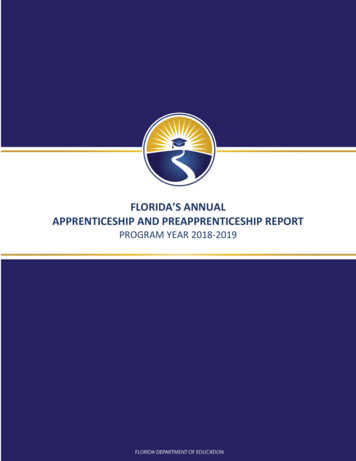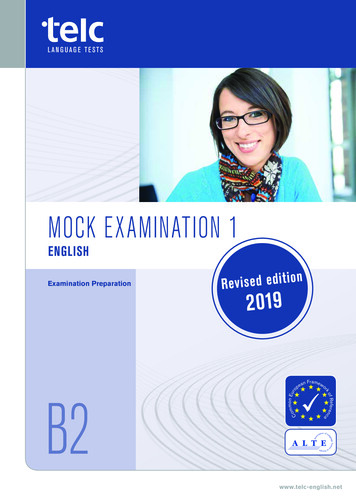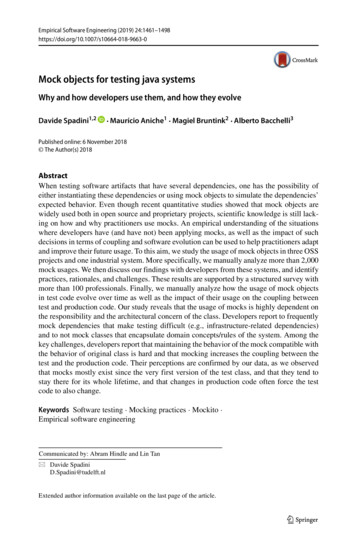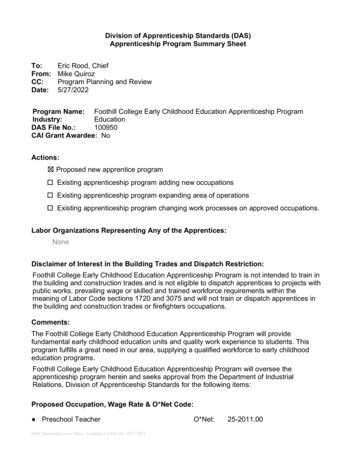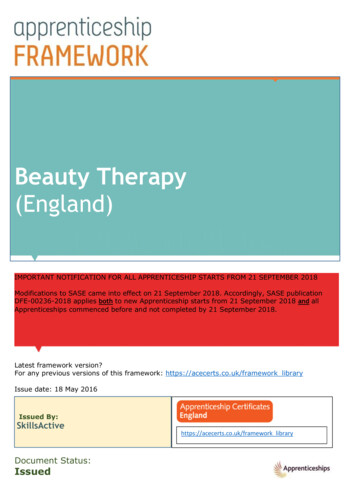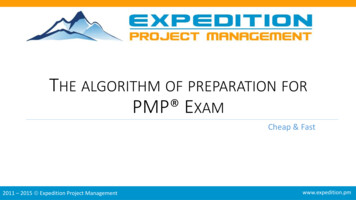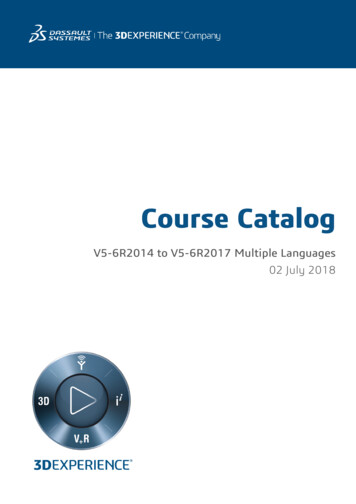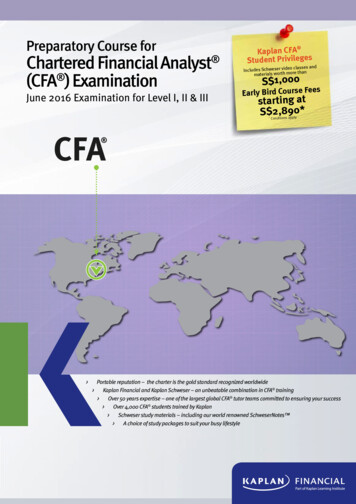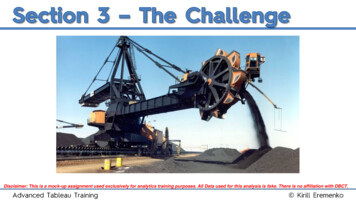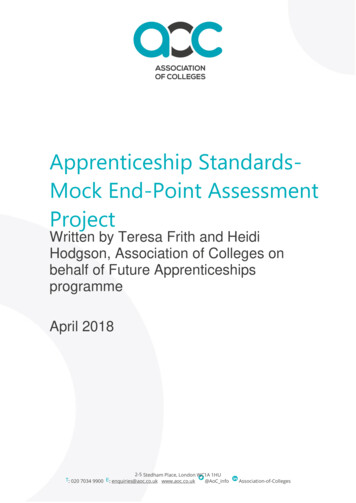
Transcription
Apprenticeship StandardsMock End-Point AssessmentProjectWritten by Teresa Frith and HeidiHodgson, Association of Colleges onbehalf of Future ApprenticeshipsprogrammeApril 20182-5 Stedham Place, London WC1A 1HUT: 020 7034 9900 E: enquiries@aoc.co.uk www.aoc.co.uk@AoC infoAssociation-of-Colleges
Mock End-Point Assessments for ApprenticeshipStandards.SECTION 1 - EXECUTIVE SUMMARY . 3SECTION 2- INTRODUCTION AND BACKGROUND . 5SECTION 3 - MOCK END-POINT ASSESSMENT PROJECT – OBJECTIVES . 6SECTION 4 - PROJECT SET-UP AND DESIGN . 64.1. Sourcing the Apprenticeship Standards to be involved . 74.2. Set-up and running of the EPA . 74.3. Research phase-survey of project participants .114.3.1 The survey .114.3.2 Feedback from project leads .124.4. Reporting.12SECTION 5 - RESEARCH FINDINGS AND RECOMMENDATIONS .125.1. Preparation for the EPA .135.2. During the EPA process .165.3. Grading and feedback .18SECTION 6 – CONCLUSION.20SECTION 7 – ACKNOWLEDGEMENTS .20APPENDIX 1 – SURVEY QUESTIONS .21APPENDIX 2 – DETAILED FEEDBACK FROM EACH APPRENTICESHIP STANDARD’SMOCK ASSESSMENT .282
SECTION 1 - EXECUTIVE SUMMARYThe ETF funded Future Apprenticeships Project commissioned the Association ofColleges (AoC) to undertake some early research into End-Point Assessments(EPAs). The objective was to test and trial apprenticeship EPA activity consideringa range of areas such as the resources used by End-Point AssessmentOrganisations (EPAOs), the consistency of grading by Independent Assessors(IAs), and so on. The purpose of the research was to gain a greaterunderstanding of what leads to an effective EPA experience for all stakeholdersand to share these findings prior to the major roll out of EPA across allapprenticeship standard delivery. This report contains the findings andconclusions of this research.Although the original intent was to use ‘live’ EPAs, it became clear that this wouldprove to be too disruptive for those involved. As EPA is a new process there wasalso an understandable level of reticence amongst those leading the way to putthemselves ‘under the microscope’. In order to develop insights we arrangedmock assessments to help plan, test and implement EPAs. It became clear thatsuch a test process prior to actual roll out of EPA was a positive and valuabletool. Feedback on the experience, from all participants was positive, and thosedelivering the EPA (assessment organisations), were able to take away valuablelessons and action points to implement prior of full rollout.Through carrying out mock EPAs it became clear that some areas do need to berefined and standardised to ensure a consistent robust EPA process. The keyfindings and recommendations of this research are listed below: Standardisation in assessment processEPAOs need to give clear guidance to their assessors on the way inwhich the EPA must be conducted, especially concerning how theycommunicate with the candidates. The aim of the guidance is toachieve consistency in approach, regardless of environmental,resource or delivery team variations. Standardisation in EPA related jargon and acronyms3
Standardisation of the language around EPA would help moststakeholders, particularly for apprentices, employers and trainingproviders, all of whom may be involved with multiple apprenticeshipstandards and multiple EPAOs. This might be a role for the Institute ofApprenticeships? Use of certain types of evidence with apprentices who are under18 at the point of their EPA needs to be carefully consideredConsideration needs to be given to the permissions required beforeusing certain types of evidence in EPA, such as video, when the learneris under 18. This should be captured in the contract between the EPAOand the training provider. Realistic volumesThe EPA process is time consuming in delivery. Timetabling of EPAneeds to reflect this, especially where employers need to be (can be)present. Roles and responsibilities are fully detailedAlthough roles and responsibilities for all those involved in the endpoint assessment are normally detailed in summary in the assessmentplan, it is clear that more detail is required at an operational level toensure that the EPA runs smoothly. This appears particularlyimportant for training providers so they understand their role,particularly in administrative preparations for the EPA and preparingthe apprentices themselves. This detail will also support pricingdiscussions with the employer. Contracts between training providers and EPAOs, and betweentraining providers and employers need to cover a range ofeventualities resulting in additional costIt needs to be clear who will pay for the cancellation/postponement ofthe EPA in a range of circumstances, or for the cost of additional timeneeded. When things go wrong4
Contingency plans need to be in place for unexpected occurrencessuch as interruptions to the EPA, work emergencies, etc. that delay orresult in EPA postponement, or disadvantage the learner in any way. Trial and TestIt is strongly recommended that EPAOs run mock EPAs to test thetimings and practicality of their delivery and assessment methods, aswell as to assess the robustness of the guidance provided to theirassessors beforehand and the preparation and support given toapprentices. A fair experience for all apprenticesAll apprentices should be given adequate access to preparatoryactivities commensurate with their needs. EPA planning should beconsiderate of apprentices working patterns and make every attemptto ensure that apprentices are put at ease prior to the start of theassessment. Post EPA processesEPAOs need to ensure that all apprentices are aware of how and whenoutcome and grading decisions will be communicated to them and theprocess that will be undertaken to arrive at the final decision.SECTION 2- INTRODUCTION AND BACKGROUNDThis project is a follow-on from the Mock End-Point Assessment activity that wascarried out in September 2016, as part of the Future Apprenticeships project.This project aims to provide advice and guidance on the apprenticeship reformagenda for training providers. The apprenticeship reforms, implemented as aresult of the Richard Review, created, amongst other changes, a shift away fromformal, on-programme assessment for apprenticeships, to competence beingfully assessed by an end-point assessment (EPA), with on-programmeassessment providing an informal check on progression. These EPAs aredesigned by End Point Assessment Organisations (EPAOs) and are based onassessment plans developed by trailblazer employer groups and approved bythe Institute for Apprenticeships (IfA). The employer groups also create the new5
apprenticeship standards which provide the basis for their delivery content. Theapprenticeship standard describes the skills, knowledge and behaviours anapprentice needs to acquire in order to be competent in their job. Theassessment plan defines how that competence should be assessed in the EPA.The move to EPA marks a significant shift in apprenticeships policy – and a verynew way of working for all involved. It is important, therefore, to test out the EPAprocess to support successful implementation.SECTION 3 - MOCK END-POINT ASSESSMENT PROJECT – OBJECTIVESThe key objectives of this research were to test and trial EPAs before a fullrollout, to test out materials used and to obtain learnings that could be sharedmore widely. The project ran over the course of summer 2017.Participants in the project established mock EPAs for a small number of‘apprentices’ who were not currently undertaking the new apprenticeshipstandard. The ‘apprentices’ were put through an EPA that was as close to ‘real’conditions as possible. In some instances this process concentrated on oneaspect or part of the EPA process. The aim was to test the planning,organisation, process and delivery of the EPA and to assess the resources usedby the Independent Assessors (IA). Learning would be obtained by surveying allstakeholders involved in the mock EPA; further in-depth feedback would begathered from the project leads. This feedback would be published to supportothers delivering and supporting EPAs in the future. This report provides thisfeedback.SECTION 4 - PROJECT SET-UP AND DESIGNProject stages6
4.1. Sourcing the Apprenticeship Standards to be involvedStakeholders were identified who were involved in apprenticeship standard EPA,who were willing and able to run a mock EPA. It became clear that despite thenumber of apprenticeship standards that are approved for delivery or beingdelivered already, there were a limited number that were in a position to deliveran EPA, even in mock format, within the project timeline.Through a combination of desk research and interviews with stakeholdersinvolved in the trailblazer process (including professional and sector bodies,training providers, awarding organisations, sector skills councils, EPAOs andemployers) two EPAOs were identified to take part in the project.Organisations involved in the mock EPA project were: Innovate Awarding: Commis Chef apprenticeship standard HighfieldQualificationsAdult Care Worker apprenticeshipstandard Innovate AwardingHospitalityTeamapprenticeship standard HighfieldQualificationsRetailer apprenticeship standardMember4.2. Set-up and running of the EPAThe project leads were briefed on the objectives and scope of the project. It wastheir role to recruit the required partners to deliver the mock EPA. Partnersincluded employers; training providers, mock ‘apprentices’ and IndependentAssessors.7
4.2.1 Commis Chef Apprenticeship standard – led by Innovate AwardingStandard and assessment overviewThis Level 2 apprenticeship is designed for the Commis Chef role, supportingapprentices to work in a number of different hospitality environments.Innovate Awarding led the mock project. They are an approved EPAO for theCommis Chef standard.The mock EPA project focused on the culinary challenge element of the EPA. Theprofessional discussion, practical observation and the on-demand testcomponents of the Commis Chef EPA were not part of this mock assessmentproject.Published standard and assessment plans can be found on the Institute forApprenticeships website.Mock end-point assessment overviewInnovate Awarding sourced partners to support the delivery of the mock EPA,this was carried out twice, in Blackpool and in Milton Keynes. Hilton hotelsprovided the employer in both instances.Partners included: Lifetime Training (training organisation) – an established delivery partnerof Hilton on the existing apprenticeship framework. Two employers from the Hilton group. Hilton hotels in Blackpool andMilton Keynes were used as assessment centres. Two mock ‘apprentices’ (these individuals had already completedFramework qualifications: Professional Cookery Level 3; and ProfessionalCookery Level 2 and so were skilled workers). An independent assessor and quality assurance lead from People 1st.All of the partners were given the opportunity to complete the project survey(Appendix 1) following the conclusion of the EPA.8
4.2.2 Adult Care Worker apprenticeship standard – led by HighfieldQualificationsStandard and assessment overviewThis Level 2 apprenticeship is designed for the Adult Care Worker role,supporting apprentices to work in a number of different environments.The mock project was led by Highfields Qualification, an approved EPAO for theAdult Care Worker standard.This mock EPA focused on the situational judgement test of the EPA. Theprofessional discussion components of the Adult Care Worker EPA were not partof this mock assessment project.Published standard and assessment plans can be found on the Institute forApprenticeships website.Mock end-point assessment overviewHighfields sourced partners to support the delivery of the mock EPA: Fairways Care Homes as the employer Two mock “apprentices”, from the above employer An independent assessor provided by Fairways Homes (as this was amock and at the time of the mock assessment Highfields did not have atrained IA for this standard)The delivery partners and additional observers were given the opportunity tocomplete the survey (Appendix 1) following the assessment day.4.2.3 Hospitality Team Member apprenticeship standard – led by InnovateAwardingStandard and assessment overviewThis Level 2 apprenticeship is designed for the Hospitality Team Member role,supporting apprentices to work in a number of different environments.The mock project was led by Innovate Awarding, an approved EPAO for theHospitality Team Leader standard.9
The mock EPA project focused on the culinary challenge element of the EPA. Theprofessional discussion, practical observation and the on-demand testcomponents of the Commis Chef EPA were not part of this mock assessmentproject.Published standard and assessment plans can be found on the Institute forApprenticeships website.Mock end-point assessment overview Lifetime Training (training organisation) – an established delivery partnerof Hilton on the existing apprenticeship framework. An employer from the sector - Hilton Hotels (both assessments werecarried out in the Hilton Hotels as the assessment centres- Blackpool andMilton Keynes) One mock ‘apprentice’ from Hilton Hotels, Front of House Team – anexisting skilled worker Innovate provided an independent assessor.The delivery partners and additional observers were given the opportunity tocomplete the survey (Appendix 1) following the assessment day.4.2.4 Retailer apprenticeship standard - led by Highfield QualificationsStandard and assessment overviewThis Level 2 apprenticeship is designed for the Retailer role, supportingapprentices to work in a number of different environments.The mock project was led by Highfield Qualifications, an approved EPAO for theRetailer standard.The mock EPA project focused on all the requirements of EPA including: on-demand test practical observation professional discussion10
Published standard and assessment plans can be found on the Institute forApprenticeships website.Mock end-point assessment overview A S Watson (training organisation) – an established delivery partner ofSuperdrug PLC on the existing apprenticeship framework Two employers – both from Superdrug PLC (both assessments werecarried out in the Superdrug/Savers stores as the assessment centresSuperdrug Doncaster and Savers in Newark) Three mock ‘apprentices’, two from Superdrug in Doncaster and one fromSavers in Newark. (These individuals held the Retailer Level 2 Frameworkand were taking part as skilled workers.) An independent assessor and quality assurance lead from People 1st.Each of the delivery partners and stakeholders was given the opportunity tocomplete the survey (Appendix 1) following completion of the EPA.4.3. Research phase-survey of project participantsThe next phase of project delivery was to undertake a survey of participants andgain detailed feedback from the project leads.4.3.1 The surveyThe survey was completed online for ease of delivery, with participants receivinga link to the survey via email. Participants were also given the option ofcompleting the survey via telephone if they preferred, but only one requestedthis option. The survey took around 10-15 minutes to complete and includedclosed and open questions to allow participants to provide more detailedfeedback where appropriate. A copy of the survey can be found at appendix 1.The survey questions covered three different elements of the EPA:1. Preparation for the EPA.2. The delivery process of the EPA.11
3. Grading and feedback.Respondents were asked tailored questions, dependent on their category: Independent assessment organisation or assessor Employers Training organisations Apprentices (to include all those who undertook the assessment as analready skilled worker to carry out the mock EPA).4.3.2 Feedback from project leadsIn addition to completing the online survey, project leads also took part in afacilitated telephone discussion with an AoC representative. This gave the leadsfrom each standard an opportunity to elaborate on their survey responses. Thediscussions focused on key outcomes and actions from the project, whichincluded: what can be improved; what went well; and key actions and next steps.4.4. ReportingThe final project stage collated the evidence and feedback to write this report.The findings and recommendations in the report are taken from a combinationof the survey results and facilitated discussions with project leads, plus insightsgained during the project by AoC project managers. It is worth noting thatrespondent numbers are low due to the nature of the project and therefore theresults are generally qualitative, which provides us with indicative insights andrecommendations. The project leads from each standard were given theopportunity to review and feedback on this report prior to publication.SECTION 5 - RESEARCH FINDINGS AND RECOMMENDATIONSThis section reports the key findings from each stage of the process, as indicatedby the online survey and facilitated discussions. It also outlines broadrecommendations for next steps. More sector and standard specific findings,which will also be of interest, can be found in appendix 2.12
5.1. Preparation for the EPAWhen asked about their overall impression of the preparation of the EPA, themajority1 of respondents had a good or very good impression. This was similaracross all the standards. Satisfaction was also generally high among each of therespondent types, although results were slightly less positive amongapprentices.When considering whether respondents had sufficient time to prepare for theEPA, and as a result felt equipped for it, most were satisfied. The majority ofapprentices felt prepared when going into the end-point assessment2. Across allstandards, a significant proportion of apprentices said they spent about oneweek preparing for the EPA. It is worth noting that one of the “mock apprentices”filled in for one who called in sick on the assessment day, so understandably sheadded that she was not fully prepared, nor had time to practice. It should also benoted that not all the mock EPA activity covered the full requirement for EPA forthat standard, and the subjects who took the tests were already skilled workers,so a preparation time of one week should not be assumed to be of anysignificant meaning.The majority of employers felt enough preparation time was provided, and thattheir apprentices were sufficiently equipped for the EPA3.Assessment organisations and/or assessors and training providers3 also felt thatpreparation time was sufficient, however with one saying that they disagreed,this was the last-minute stand-in learner, but he was confident that hisWhen asked: ‘On a scale of 1 to 5, what was your overall impression of the preparation for theend-point assessment (EPA)? (with 1 being ‘my overall impression was very poor’ and 5 being ‘myoverall impression was very good’),’ However one did put a 2 and when asked why they scored solow, it was because they had read the scale wrong and actually mend to put a 4 meaning goodoverall.2When asked on a scale of 1 to 5 were you given enough time for the mock assessment (this isspecifically dedicated to preparing you for the EPA and when asked if they felt fully prepared)? (with 1being ‘my overall impression was very poor’ and 5 being ‘my overall impression was very good’), 3When asked the question My apprentices were fully prepared 66% said that the neither agreed/nordisagreed.3All but one assessment organisation representative and one training provider replied,‘slightly agree/entirely agree’ to these questions (the remaining replied ‘neither agree nordisagree). 5 All parties agree that they had more than one week to prepare with the exception of thestand-in“mock Apprentice”113
replacement “mock apprentice” was well equipped for the observation, whichindeed she did pass successfully.A majority of the learners had more than one week to prepare for the mockEPA5.When asked the question “what did preparation look like, what did it include”?The majority fed back4 that the employers played a very supportive role, with66% of “mock apprentices” saying that they had help from their employer, alongwith this the majority also identified tutor led mock assessments5.One of the Hilton “mock apprentices” made a suggestion to help make guidancefor preparation more clear;“It would be helpful to know what food and kitchen workplace prep wasacceptable to do before-hand. E.g. demonstrate cleaning section prior toassessment and setup of machinery.”It would perhaps be useful then to consider gaining feedback from apprenticeswho undertake EPA to help improve future iterations.Summary: preparation of the EPAWhen setting up this project and confirming participants to take part, it was clearthat many stakeholders did not feel ready to undertake a mock EPA and did nothave any learners at a stage of gateway (in early summer 2017). However, allagreed that it was a concept they would find helpful. It would provide a goodopportunity to test all the resources and processes developed for EPA withoutrisking the achievement of existing learners. Recommendation: This projectshould be repeated early 2018 when more standards/participants are ready tobe involved. We would also encourage assessment organisations and therelevant stakeholders to undertake mock assessment activity as early aspossible, even if they do not feel completely ‘ready’. Participants made it clearthat the mock activity can drive implementation and provide a sharper plan forfull delivery.45With exception of the Training Providers.Other resources mentioned were Self help guides, Help from Training Provider and practicing.14
It is clear that preparation for EPAs is important and should be factoredinto the information and timing plans given to apprentices and other keystakeholders. Information provided in advance of the EPAs should be clear andcomprehensive so that all involved know what to expect and what theirrole is. Even across this small sample of EPAs, a number of things went wrongwhich would have resulted in an additional cost being incurred that wouldnot have been covered within the current ESFA funding. Given thecomplexity of the arrangements required to deliver EPA, sucheventualities need to be factored in to the planning phase of EPA delivery.A key element concerned the timing of the assessments where insufficienttime had been allowed for the EPA itself and for assessor deliberationpost assessment.Key Recommendations:Roles and responsibilities are fully detailedAlthough roles and responsibilities for all those involved in the EPA are normallydetailed in summary in the Assessment Plan, it is clear that more detail isrequired at an operational level to ensure that the EPA runs smoothly. Thisappears particularly important for training organisations, so they understandwhat their role is. This detail will also support their pricing discussions with theemployer.Realistic volumesThe EPA process is time consuming in delivery. Timetabling of EPA needs toreflect this, especially where employers need to be (or can be) present.Contracts between training providers and EPAOs, and between training providersand employers need to cover a range of eventualities resulting in additional costIt needs to be clear who will pay for the cancellation/postponement of the EPA ina range of circumstances, or for the cost of additional time needed.15
When things go wrongContingency plans need to be in place for unexpected occurrences such asinterruptions to the EPA, work emergencies, etc. that delay or result in EPApostponement, or disadvantage the learner in any way.5.2. During the EPA processOverall impressions of the EPA were very good6. More than three quarters of allrespondents had a good overall impression; this result stands across allrespondent types and is generally true for each of the standards involvedAn Adult Care Worker “mock apprentice” commented:“All aspects of the EPA were very well thought through and ran smoothly andit was a great experience to have taken part in.”A Commis Chef “mock apprentice” commented:“I have not received grading at this time. I feel an apprentice should be able tojudge their own dish first to spot their mistakes. This gives the apprentice anopportunity to test their knowledge and self-improve. Also during the exam, Ifelt like I had a bit too many kitchen and H&S related questions. This was aslightly distracting amount, especially given the 2hr limit”We asked respondents how organised they felt the EPA was and how smoothly itran. Results indicate that the majority of respondents were happy with theorganisation. The results were fairly consistent across standards and respondenttypes.One employer commented:“Brilliant experience thank you, would recommend this happenspermanently.”Another employer commented:“It was very professional and (they were) easy people to deal with”When asked the question: ‘On a scale of 1 to 5, what was your overall impression of theendpoint assessment (EPA) during the process? (with 1 being ‘my overall impression was verypoor’ and 5 being ‘my overall impression was very good’)’, most respondents answered either 4 or5 (based on the total sample).616
A Retailer employer/provider said:“The language used suited our business and the learner was fully engaged atall times. The observations weren't intrusive and a good rapport was quicklyestablished between the EPA assessor and the store team.”Summary: during the EPA process All stakeholders appear to have learnt lessons from the mock EPAprocess. It became clear that there are still lessons to learn within boththe preparation and the delivery phases of EPA, and the EPAOs need totest their resources and processes to ensure that all aspects aredeliverable and repeatable across a range of scenarios before a major rollout. As a general observation across the range of mock assessments, whilstvariation in approach and delivery is to be expected across differing EPAsfor different standards, it would be very helpful for those with regularengagement to see a level of standardisation within the process andwithin the emerging jargon and acronyms used by the EPAOs.Key Recommendations:Trial and TestIt is strongly recommended that EPAOs run mock EPAs to test the timings andpracticality of their delivery and assessment methods, as well as to assess therobustness of the guidance provided to their assessors beforehand and thepreparation and support given to apprentices.Standardisation in assessment processEPAOs need to give clear guidance to their assessors on the way in which theEPA must be conducted, especially concerning how they communicate with thecandidates. The aim of the guidance is to achieve consistency in approach,regardless of environmental, resource or delivery team variations.Standardisation in EPA related jargon and acronymsStandardisation of the language around EPA would help most stakeholders,particularly for apprentices, employers and training providers, all of whom may17
be involved with multiple apprenticeship standards and multiple EPAOs. Thismight be a role for the Institute of Apprenticeships?Roles and responsibilities are fully detailedAlthough roles and responsibilities for all those involved in the EPA are normallydetailed in summary in the assessment plan, it is clear that more detail isrequired at an operational level to ensure that the EPA runs smoothly. Thisappears particularly important for training providers so they understand theirrole, particularly in administrative preparations for the EPA and preparing theapprentices themselves. This detail will also support pricing discussions with theemployer5.3. Grading and feedbackSummary: grading and feedbackWhen asked the question what was your overall impression of the feedback,evaluation and grading (where known) of the EPA (with 1 being “my overallimpression was poor” and 5 being “my overall impression was very good” therewas an overwhelming response to good or very good and only one “mockapprentice” put neither agree/nor disagree, this apprentice had not at the timeof writing received a grade.A training provider for retail added they “Found that the day ran smoothly, ittook longer than expected but wasn't intrusive. The learner was able toshowcase their knowledge and demonstrate their skills in their ownenvironment. They were put at ease quickly and weren't put under pressure.Good interaction and feedback given after each stage.With regards to the test I had feedback from the learners that some of thequestions were difficult to understand and needed to be read a few times.Some of the answers were very similar too. “One of the EPAOs said
2 - 5 Stedham Place, London WC1A 1HU T: 020 7034 9900 E: enquiries@aoc.co.uk www.aoc.co.u @AoC_info of - - Colleges Apprenticeship Standards
